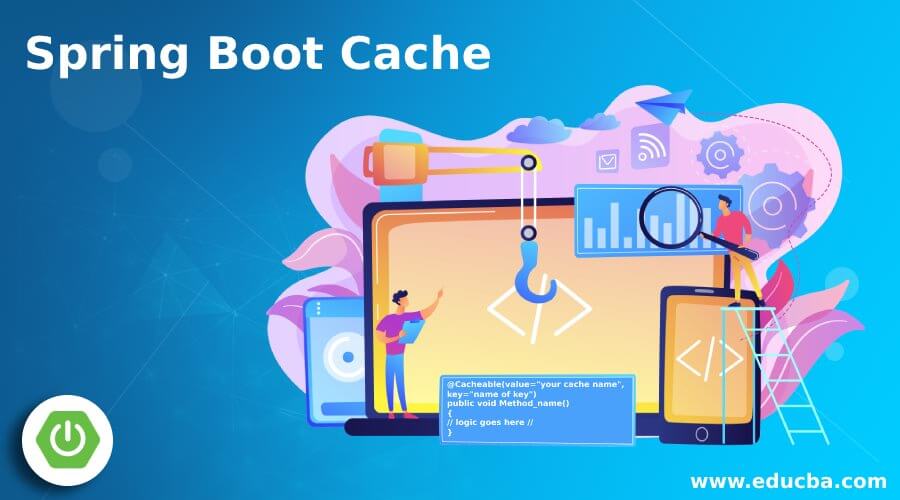Updated April 17, 2023
Introduction to Spring Boot Cache
Spring boot provides us strong caching method which can be used to prevent the number of executions of a particular code. By using a cache, we can store the data into a disk or the memory itself, which prevents us from the unnecessary access to a similar type of data in the code. A cache can improve the performance of the code by reducing the number of execution for the same data again and again with the same information. In spring boot, to implement this concept, we have caching abstraction in general, which is easily used to implement the cache mechanism.
Syntax of Spring Boot Cache
As we know that we need to follow the caching abstraction to use this, we will have a closer look at the syntax for we can configure caching in the spring boot application.
@Cacheable(value="your cache name", key="name of key")
public void Method_name()
{
// logic goes here //
}As you can see in the above line of syntax, we have used @Cacheable annotation, which is used to define the method as cache method in spring boot. So it will cache the mentioned key in the parameter and return us the result from the cache if the key is the same for that and hence prevent the execution time.
Let’s take a look at the sample piece of the syntax of the cache configuration in spring-boot:
Example:
@Cacheable(value="cachedemo", key="#rollNo")
public String employeedetail()
{
// logic goes here. //
}How does Cache work in Spring Boot?
As of now, we already know that cache can prevent the number of execution for the same record or the same key by storing the data into memory or disk. Also, it helps us to increase the application performance as well. We can easily implement this in the spring boot application by following the simple steps.
Here we will first see the step required and the code changes that we have to make in order to cache the data into the memory or disk in our application.
1. @EnableCaching
First, we need to annotate our main spring boot class with this annotation. This annotation will simply create a cache manager for us. Suppose you have not yet created any cachemanager instance to create an in-memory cachemanager for us by using the HashMap from Java. So this annotation is required to setup the cache mechanism in the spring boot application.
Let’s taken a look at the syntax required to configure this:
@SpringBootApplication
@EnableCaching
public class CachingApplicationDemo
{
public static void main(String[] args)
{
SpringApplication.run(CachingApplicationDemo.class, args);
}
}As you can see in the above piece of code, we have used to @EnableCaching annotation; also, in order to use this, we have to import the below-mentioned package into our application like below:
import org.springframework.cache.annotation;2. @Cacheable
This annotation can be used if you want to enable the cache at the method level in an application; also, we can define the parameter that will create a cache for us with some specified name and key. This key is required to identify the records from the cache list uniquely.
Let’s see its syntax how we can use this while programming:
@Cacheable(value="cacheempdetails", key="#empid")
public List<Employee> employeeData()
{
// our code will goes here //
return result;
}Here as you can see, we have defined the name of the cache by using the value attribute, which means we can use the cache by this name. Also, we have given one key here to identify the records uniquely.
3. @Caching
We can use this annotation at the method level; it is mainly used when we required two annotations such as cacheevict and cacheput.
Below see the syntax to use this while programming:
@Caching(evict = {@CacheEvict("some value"), @CacheEvict(value="value", key="your key") })
public String msg(Employee emp)
{
// logic goes here //
}We can use the cacheevict annotation on the method, and it is used to remove or delete the unused data from the cache. if we want to delete all entries from the cache, then we can use all entries attribute of the cacheevict by mentioning its value as true. @cacheput is also used on the methods; as the name suggests, it is used to update the cache, and it will not disturb the method execution that is currently being going on. Both this annotation are easy to use and handle in spring boot application.
Steps are mentioned below to make use of cache in spring boot application, also mentioned the required dependency; you can use this as per the build tool you are using in your application to run and build the application we have added for maven.
1. We need to add the following dependency in our pom.xml file in order to use the above-defined cache annotations in the spring boot application.
Example:
<dependency>
<groupId>org.springframework.boot</groupId>
<artifactId>spring-boot-starter-cache</artifactId>
</dependency>2. you can create the spring boot application by using the spring initializer online and extract the zip.
3. Import the project into your editor and start making the configuration and changes which is required to cache the data.
Conclusion
By the use of a cache, we can store the frequent access data into the memory or disk, which can reduce the number of execution; this execution can be so expensive, which can further impact the performic of the application, so we can easily configure this caching mechanism in our code by simple steps and start using it.
Recommended Articles
This is a guide to Spring Boot Cache. Here we discuss the introduction and how cache works in spring boot? For better understanding. You may also have a look at the following articles to learn more –



